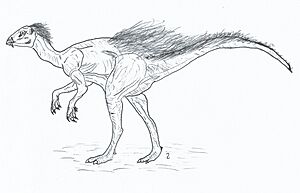Komlosaurus facts for kids
Komlosaurus (which means "Komló lizard") is a fascinating dinosaur that we know about only from its footprints. These special dinosaur tracks were discovered in Hungary, a country in Europe. Even though we haven't found any bones of Komlosaurus, its footprints give us important clues about what this ancient creature might have been like and how it lived millions of years ago.
Contents
What Was Komlosaurus?
Komlosaurus was a type of theropod dinosaur. Theropods were a group of dinosaurs that walked on two legs and were often meat-eaters. Famous theropods include the mighty Tyrannosaurus rex and the speedy Velociraptor. Komlosaurus was much smaller than these giants, but it shared some of their characteristics.
A Mystery Dinosaur
Because we only have footprints, Komlosaurus is a bit of a mystery. Scientists can't be absolutely sure what it looked like, how big it was, or exactly what it ate. However, by studying the shape and size of its footprints, they can make educated guesses. The tracks suggest it was a small, agile dinosaur that moved quickly on its two strong legs.
Living in the Early Jurassic
Komlosaurus lived during the Early Jurassic period. This was about 199 to 182 million years ago. During this time, the Earth looked very different from today. There were vast forests and different kinds of plants and animals roamed the land. The climate was generally warm and humid, perfect for dinosaurs to thrive.
The Clues: Dinosaur Footprints
The footprints of Komlosaurus are a type of fossil called a trace fossil. Unlike body fossils, which are the actual bones or teeth of an animal, trace fossils show us evidence of an animal's activity.
What Are Trace Fossils?
Trace fossils include things like footprints, burrows, nests, and even fossilized droppings (called coprolites). They are incredibly valuable because they tell us about how ancient animals behaved, moved, and interacted with their environment. For Komlosaurus, its footprints are the only direct evidence we have that it ever existed!
What Footprints Tell Us
Dinosaur footprints can reveal a lot. Scientists can learn about:
- Size: The length and width of the foot can give an idea of the dinosaur's overall size.
- Speed: The distance between steps can help estimate how fast the dinosaur was moving.
- Posture: The depth of the prints can suggest how heavy the dinosaur was.
- Behavior: Multiple tracks together might show if dinosaurs traveled in groups.
- Environment: The type of rock where the prints are found tells us about the ancient landscape, like if it was muddy or sandy.
Where Did Komlosaurus Live?
The footprints of Komlosaurus were found near the town of Komló in the Baranya region of southern Hungary. This area was once part of a large landmass that would eventually become Europe. The discovery site gives us a glimpse into the ancient ecosystems of this part of the world during the Early Jurassic.
How Big Was It?
Based on the size of its footprints, scientists believe Komlosaurus was a relatively small dinosaur. It was likely no bigger than a modern-day ostrich or a large dog. This makes it one of the smaller theropods known from the Early Jurassic period in Europe. Its small size would have allowed it to move quickly through the ancient landscapes, perhaps hunting smaller prey or avoiding larger predators.
Images for kids
-
Outdated restoration as an ornithischian
See also
 In Spanish: Komlosaurus para niños
In Spanish: Komlosaurus para niños



